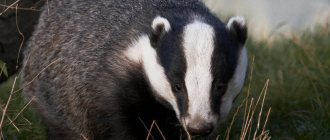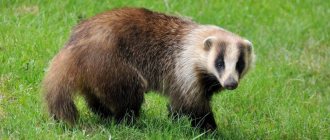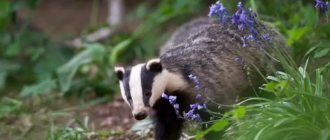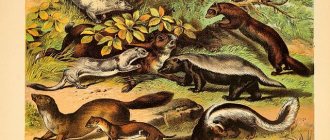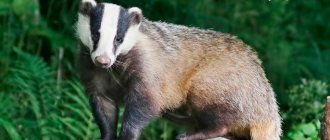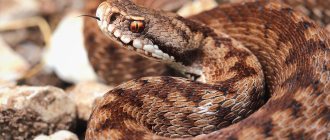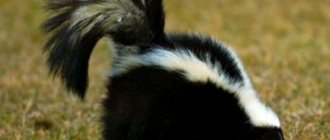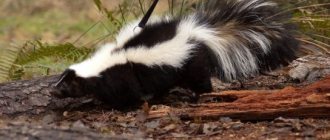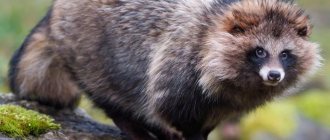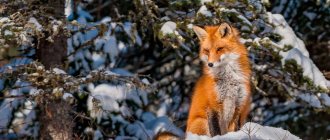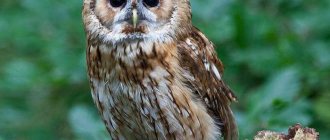04 June85666mustel family badgerpredator
The badger or common badger is a predatory mammal that is a member of the Mustelidae family. The badger animal is an amazing creature that combines an unusual appearance, an easy-going character and considerable economic benefits. Below you will find photos and descriptions of badgers and you will be able to learn a lot of interesting and new things about this forest animal.
Description of the species and origin
A badger is easily recognized by the black stripes on its eyes.
The badger is a mammal and leads a predatory lifestyle. The mustelid family to which it belongs also includes otters, ferrets, minks, martens, wolverines and many other animals. Their distinctive feature is the ability to adapt to almost all environmental conditions. Because of this, they have a large habitat.
Badgers are divided into many species with unique characteristics. They differ in habits, appearance and habitats. For example, the common badger is widespread in Russia.
It is believed that the first species of this animal appeared approximately 84 million years ago, but their appearance was significantly different from the modern one. They had a massive body and powerful jaws equipped with sharp teeth. This made it possible to chew hard objects and hunt small dinosaurs. But in the process of evolution, the size of the badger has decreased significantly.
Appearance and features
Appearance of a badger Appearance
of a badger
Appearance of a badger
Appearance of a badger
Appearance of a badger
Compared to other animals of the mustelid family, the badger is quite large in size. The length of its body can reach a meter, and its tail grows up to 25 cm. Males are always larger than females.
The badger's head tapers closer to the nose, which is why it has a cone-shaped shape. Behind the eyes are round ears. The head is connected to the body by a long neck. The back of the body is wider than the front, which makes the animal's gait seem clumsy.
Interesting fact : the weight of an adult badger is around 24 kg. But before going into hibernation, the animal gains another 10 kg of fat.
In the tail of a badger there are special glands that emit an unpleasant aroma. Smell allows animals to find relatives and communicate with each other. The animal's paws are short, but equipped with long claws and strong muscles. Thanks to this, the badger is able to dig a deep hole in a short period of time, even in hard soil. The animal's teeth are strong. Their number varies from 34 to 36, depending on the species.
The badger's fur is long and thick, and feels hard to the touch. Underneath there is an additional down layer that protects from the cold. Most individuals have a brown or gray color with a silver tint on their backs. The belly of the animal is black or dark brown. The head is white with two black stripes running through the eyes. In summer, the color of the animal darkens, and with the onset of winter it becomes several tones lighter. Badgers shed during the warm time of the day, and the fur is renewed quite quickly: in place of the fallen fur, new hair begins to grow almost immediately.
Interesting: Hedgehog - description, photo, video, features, habitat, species, nutrition, lifestyle
Habits
Badgers are nocturnal, but they can often be seen during daylight hours - in the afternoon before 8, in the evening - after 5-6 hours. Animals stick to their favorite places for generations; individual badger towns are several thousand years old. A considerable portion of the animal’s life activity takes place within 400-500 meters of permanent housing, that is, on an area of one hundred hectares.
Movements are usually slow and difficult. He walks with his head tilted to the ground. The badger is a decent swimmer, but only occasionally gets into the water of its own accord. His vision is weak - he only senses moving objects, but his hearing is good. His voice is similar to a grunt, in irritation he grumbles sharply, and in fights or attacks by predators he screams piercingly.
Nora
Single individuals use simple burrows, with a single entrance and a nesting chamber. Dilapidated cities of badgers are a multi-tiered underground structure with many (up to 40-50) entrance and ventilation holes and long passages leading to 2-3 large nesting chambers lined with dried litter, which are located at a depth of up to 5 m.
From time to time, the holes are cleaned by badgers, and the old bedding is thrown out into the street. If nothing bothers the owners, the hole is given by inheritance, each subsequent generation making its contribution to the construction of a labor-intensive dwelling. An elderly badger - an area occupied by a huge burrow - can be located on an area of up to one hectare. If circumstances permit, a family of badgers has 2-3 burrows, which they change, living in each one for 2-4 weeks. Often the surrounding burrows are connected by passages, thus creating badger towns. Residents communicate without conflict by visiting their neighbors' holes. A badger's hole is always quite tidy; there are no fragments of half-eaten food lying around, as is often the case with a fox.
Wintering
Badgers are the only mustelids that hibernate during the winter. By the autumn season, the animal accumulates reserves of subcutaneous fat, causing its weight to approximately double. By the time of nesting, the hole has already been cleaned, the nesting chamber is filled with the freshest litter, the entrance holes are covered with soil and leaves. If a number of animals live in a common badger for the winter, each one sleeps in a separate nesting chamber.
Habitat - where badgers live
Habitat of the badger
Badgers live in burrows that they dig themselves. Inside the home there are a large number of corridors and passages. This is due to the fact that 10-15 badger families can live in this house at the same time, which are constantly building new tunnels.
Interesting fact : badgers often allow rabbits and foxes into their holes, because they don’t mind sharing their territory with other animals.
The number of individuals living in a hole depends on the amount of food available in the surrounding areas. If it is not enough, some badgers leave these lands and go in search of more favorable conditions.
Badger at the entrance to his hole
Members of the same flock distinguish each other by smell. If a foreign animal or a badger from other territories wanders into a hole, they immediately understand it. If a threat arises, the leader takes upon himself the responsibility of driving away the uninvited guest.
Badgers keep their burrows clean. They take all the garbage outside, and in most cases even their toilet is located in another place, outside their home.
Relationships with other animals
Badgers are not at all aggressive animals. They are so tolerant of each other that several families can live in one home. Badgers have no natural enemies, only humans are dangerous to them. But young animals can be hunted by wolves and bears. And adult animals are very cautious and prefer to move away and hide in a hole, although even a large predator has a hard time coping with such an opponent.
If he gets angry, he squeals loudly and bites, and can also seriously injure the offender with his claws. Sometimes other animals move into the badger's hole: raccoons, ferrets, martens or foxes. As long as they do not bother the owner, he tolerates them, he just fences himself off. But the badger is a very clean animal, so quite often he drives foxes out of his home.
What does a badger eat?
The animal is most active at night. When darkness falls, the badger goes in search of food. Its diet is quite varied, but most of all the animal prefers frogs, lizards and small rodents. If possible, he may also feast on small birds and their eggs. The badger does not shy away from insects: worms, snails and beetles also go into its mouth. The animal sometimes attacks fairly large animals, for example, hares.
Badger regularly eats different berries
Interesting fact : a badger can hunt snakes, and their poison does not affect it, which gives a great advantage in a fight with them.
Plant foods are also present in the badger's diet. He can eat berries, mushrooms, nuts and grass. In times of famine, the animal uses its long claws to pull out roots and eat them. There are cases when badgers wander into vegetable gardens and eat corn, potatoes and legumes. Every day the animal consumes about half a kilogram of food. When frost approaches, he begins to eat more food in order to gain weight.
Nutrition
In spring and summer, the badger's food consists mainly of roots, insects, snails and earthworms. On occasion, he can attack a young hare or destroy a bird's nest. It can also drag away a fallen chick or climb into a honeycomb. In autumn, it feeds on fallen fruits and does not disdain mice, moles, frogs, and snakes.
Sometimes wild badgers can crawl into a person’s yard and steal poultry. In general, the animal behaves like a predator, which it is. In Eastern Siberia, badgers were seen attacking calves, causing great harm to the villagers. This behavior forces a person to put traps and traps on him.
However, the benefit that the animal brings is much greater than the damage and harm it causes. In fact, it cleanses nature of harmful insects. These animals are tireless and gifted hunters. In one hunt they are able to catch up to 70 victims. They eat little by little, leaving food that is not eaten immediately in reserve.
Only closer to autumn do they begin to feed heavily, gaining weight for hibernation. At this moment, the badger’s fur becomes stronger, its abdomen is rounded, and it moves more slowly than usual. Tries to conserve energy for hibernation. Its weight at this moment can reach 35 kg.
The study of badger nutrition is seriously studied in institutes, nature reserves and reserves, because this can affect the entire ecosystem of the region. It turned out that the diet of this animal includes vertebrates (rodents, insectivores, lagomorphs, birds, reptiles, fish) and invertebrates (gastropods, various ground beetles, coleopterans, carnivores, lamelatiforms, their larvae, bumblebees, hymenoptera, wasps, sawfly cocoons , Orthoptera, Diptera, Hemiptera).
The badgers' menu also includes plants and berries - strawberries, bird cherry, roots of some plants and oats. Plant foods are less common in the animal's diet than animal foods. And from animal food insects and weakened animals predominate. Whatever one may say, the badger can safely be called a “forest cleaner.”
Features of character and lifestyle
The badger has a rather friendly character and rarely shows aggression. If danger arises, the animal will most likely try to run away rather than start a fight. If he fails to hide, he is capable of biting or hitting the enemy, after which he will try to hide. Even though the badger goes hunting at night, it is quite easy to spot. The animal is clumsy and makes a lot of noise when moving.
The animal has poor eyesight and an excellent sense of smell. The latter helps him navigate space and find food. A badger's hearing is sensitive: it hears perfectly and can accurately determine the distance to a target by sound.
In most cases, these animals live in families and try to take care of loved ones. Badgers do not like to move to other territories. As a rule, the constructed burrow is used by individuals throughout their lives, and sometimes even by subsequent generations.
Interesting: Animals of Russia - mammals, birds, reptiles, amphibians, fish, photos and videos
What does he do in winter
Badger hibernation is similar to bear hibernation. They do not sleep in winter only where there is no frost. But most often, badgers eat fat in the fall, almost doubling in weight, and repair the hole, preparing it for hibernation. They insulate the nest by carrying moss and dry leaves there. The badger throws away the old bedding, as it is very clean. These animals also store food, putting it in special storerooms in their burrows. The roots and grains of plants will be very useful to the badger when he wakes up hungry in the spring. They stop appearing on the surface after the onset of frost and snowfall, and in the spring they emerge with the beginning of snow melting. Before hibernation, this animal clogs all the holes in its burrow with earth and dry leaves.
Social structure and reproduction
Badgers live in families
. Badgers are monogamous. Having found a soul mate, they live with her all their lives. A male can have offspring in the fourth year of life, and a female in the third. Badgers breed between March and April, and pregnancy lasts from 9 to 14 months.
Interesting fact : from 2 to 6 cubs can be born at the same time. The emerging badgers are blind and cannot hear anything.
After the birth of the offspring, the female does not leave the cubs. In the first five weeks, badger cubs quickly grow and become stronger, they develop hearing and vision. They feed on milk for three months, after which they try regular food. At six months of age, the cubs regularly emerge from the hole and gradually begin an independent life. In the fall they go in search of new housing.
Lifestyle
Badgers often live in the forest separately from their relatives. However, the vast majority form families. If an increased number of animals is observed in one area, they form small groups. Relatives populate the badger's hole, where the dominant female and male dominate. The size of the territory controlled by the family sometimes reaches an area of about 400 hectares.
The animals mark the boundaries of their own possessions with an odorous secretion. The spread of a characteristic musky odor tells uninvited guests that the territory is already occupied. Each group of relatives has its own unique aroma of secretion, which is released from special glands located at the tail of the animal.
When a badger fails to reproduce in a dense population, the animal leads a solitary life. In such cases, the animal often finds shelter wherever it can and does not pay attention to creating, arranging and protecting the hole.
Natural enemies
A fox sneaks up on badgers.
A badger tries to lead a peaceful and quiet life, which is why it has few natural enemies. The greatest danger to him is the bear, lynx and wolf. Also, in rare cases, he is capable of conflicts with dogs and foxes.
People cause the greatest harm to badgers. Due to deforestation, large areas are becoming uninhabitable. Also in some countries, the animal is regularly hunted for its badger fat.
How to mark territory
After hibernation, every badger has one more very important job - to determine the boundaries of his hunting area. His well-being and food supply largely depend on this. On one of the first trips, the badger begins to mark its territory. His boundary pillars are trees, stones, fallen trunks, individual bushes and other objects that stand out against the background of the surrounding area.
Having chosen a boundary post, the badger carefully sniffs it, and then, turning its back, touches it with the base of its tail. Part of the secret secreted by it is transferred to the marked object. The musky smell is very persistent and remains on objects for many weeks and months.
Types of badgers
Badgers are divided into several species, and their names are directly related to their place of residence.
Common badger
Common badger
Lives in most European countries and in Russia. In most cases it has a gray-brown color with black stripes on the eyes. The body is quite massive, and the rear part of the body is much wider than the front.
Asian badger
Asian badger
Smaller in size than the common badger, it lives in Asia, but can also be found in Russia. The color of the animal is light brown, with white spots. On the eyes, the stripes are brown in color. The animal has a proportional body, which is why the back is not much larger than the front.
Japanese badger
Japanese badger
Lives only in Japan; this species is also called “tanukami”. The badger's color is brown, with light spots on the head. There are small black stripes on the eyes. The animal's head is elongated, with a large dark nose at the end.
American badger
The American Badger
Beast is found in North America. A light stripe runs through the entire body, right in the center, and there are also two on the sides. The animal's head is black, with white spots on the cheeks; its shape is not as elongated as that of other species. The color of the animal is gray, the belly is light.
Population and species status
Badgers have a fairly large habitat, and their population is not threatened. Therefore, there is no likelihood that the animal will disappear in the coming years. Despite the fact that badgers are regularly hunted, their numbers remain virtually unchanged. Even if the territory becomes uninhabitable, the animals quickly move to a new one.
Interesting: Caracal - description, nutrition, lifestyle, enemies, photos and videos
At the moment, the badger population is not in danger
Interesting fact : badgers have coarse fur, so it is not used for making clothing. But it is used in the production of painting brushes.
In addition to ensuring that badgers are not critically endangered, their activities also help many other species survive. Some animals use their holes, thereby finding a safe place for themselves.
Conservation and protection
In the wild, badgers live shorter lives than in zoos.
The badger is listed in the Red Book as a species with the least threat of extinction. This is due to the fact that the animal population is stable and is not decreasing. In areas where people actively engage in agriculture, the badger is quite rare, but in forest areas it is present in large numbers.
At the moment, people are not making serious attempts to protect this animal, since this is not necessary. However, the animal is a regular at various zoos. The badger happily lives in an artificial environment because it receives regular nutrition and all the conditions are created in its cage. This is why animals in zoos live several years longer.
Badger hunting is also allowed in Russia from September to October. This is the period when the animal has already gained weight and is preparing for the winter frosts.
Does a badger hibernate?
Badgers sleep in a specially prepared place.
Before the onset of winter frosts, badgers hibernate. Previously, the animal begins to actively eat in order to gain as much fat as possible. The animal falls asleep between October and November, depending on how quickly it has time to prepare, as well as when severe cold sets in. It comes out of hibernation in March, when the temperature no longer drops below zero. The animal spends the entire winter in a hole, along with the rest of the family.
Also, a badger may not hibernate if the winters in its habitat are not very harsh. Then the animal continues to lead a normal lifestyle, traveling through snowdrifts and looking for food. Since there is no opportunity to feast on insects and plants in the middle of the snow, the animal actively searches for roots, as well as other, smaller animals that also go out into nature in search of food. The badger’s survival is helped by the fat accumulated during the fall, thanks to which it is able to survive for a long time without food. Individuals living in zoos endure the winter most easily, since they do not have the need to go in search of food.
When is the best time to look for a badger hole?
The best time to search for an animal's home is early spring. At this time, the badger is cleaning his house and throwing out old grass from the hole, which was used to plug the exits. He also gets rid of the litter. Leaves, grass and earthen piles created by the animal while cleaning the hole are clearly visible even from afar.
It is best to look for a hole in places with high humidity. Answering the question of how to find a badger's hole in spring or late winter, we can say: it is enough to find the animal's paths, which the badger tramples for a very long time. Such paths stand out very well in the area. Traces of badger cleaning are also quite characteristic.
Scientific classification
- Domain: eukaryotes
- Kingdom: Animals
- Subkingdom: eumetazoans
- No rank: bilaterally symmetrical
- No rank: deuterostomes
- Type: chordates
- Subphylum: vertebrates
- Infratype: gnathostomes
- Superclass: quadrupeds
- Class: mammals
- Subclass: animals
- Infraclass: placental
- Superorder: Laurasiotherium
- Order: carnivores
- Suborder: Caniformes
- Family: mustelids
- Subfamily: badgers
- Genus: badgers
- Species: badger
